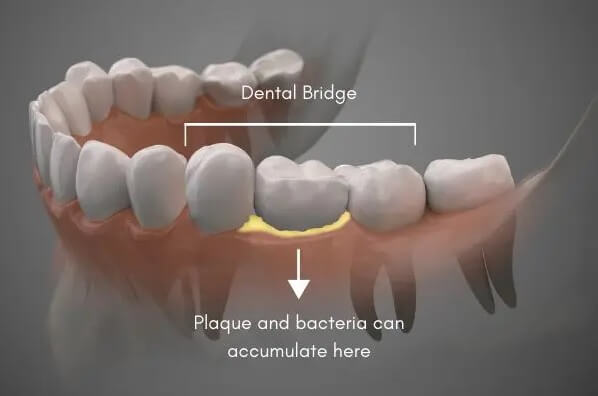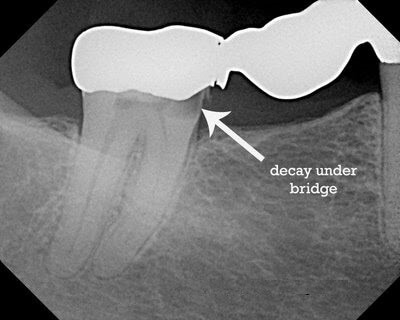A Cavity Under A Bridge

What Is A Cavity Under A Bridge?
Dental bridges are a popular tooth replacement option for those who have lost one or more teeth. A bridge is typically made up of two or more dental crowns placed on the teeth on either side of the gap, with an artificial tooth or teeth in between them. However, just like natural teeth, bridges are also susceptible to cavities, which can form underneath them.
A cavity under a bridge is essentially a hole that has formed in the tooth underneath the dental bridge. This can be caused by a number of factors, including poor oral hygiene, plaque buildup, and food debris getting trapped between the bridge and the tooth. If left untreated, a cavity under a bridge can cause the bridge to become loose or even fall out, as well as cause further decay and damage to the surrounding teeth and gums.
Before you contact a Toronto dentist to examine A Cavity Under A Bridge, there are some things you should know as a patient:
- Why Do I Have A Cavity Under My Bridge?
- Signs And Symptoms Of A Cavity Under A Bridge
- Treatment Options For A Cavity Under A ridge
- How To Prevent A Cavity Under A Bridge?
- Managing A Cavity Under A Bridge Until You Can See The Dentist
If you have questions about A Cavity Under A Bridge or other dental problems, please contact us for more information.
Why Do I Have A Cavity Under My Bridge?
There are several reasons why someone may develop a cavity under their dental bridge:
- Poor oral hygiene: Failing to brush and floss regularly can lead to the buildup of plaque and bacteria, which can cause tooth decay and cavities.
- Food debris: Food particles that get trapped under the bridge can create a breeding ground for bacteria, which can cause decay.
- Diet: Consuming acidic foods and drinks, such as soda or citrus fruits, can erode tooth enamel and make teeth more susceptible to decay.
- Poorly fitting bridge: A poorly fitted dental bridge can create gaps between the bridge and the tooth, which can allow food and bacteria to accumulate and cause decay.
It is important to practice good oral hygiene and attend regular dental check-ups to prevent cavities from developing underneath dental bridges. Your dentist can also help ensure that your bridge is properly fitted and maintained. If you have further questions about A Cavity Under A Bridge, please contact us.
Signs And Symptoms Of A Cavity Under A Bridge
It’s important to recognize the signs and symptoms of a cavity under a dental bridge, so that it can be treated promptly. Here are some common indicators:
- Tooth sensitivity: You may experience increased sensitivity to hot or cold foods and drinks.
- Tooth pain or discomfort: You may feel pain or discomfort when biting down or chewing.
- Bad breath: Bacteria that accumulates under the bridge can cause bad breath.
- Gum swelling or redness: The gum tissue around the affected tooth may become swollen or red.
- Visible holes or pits: You may be able to see small black holes or pits on the tooth surface under the bridge.
If you experience any of these symptoms, it’s important to see your dentist right away. Early intervention is key to preventing further damage and potential tooth loss. If you have further questions about A Cavity Under A Bridge, please contact us.

Treatment Options For A Cavity Under A Bridge
Treating a cavity under a dental bridge will depend on the severity of the decay and the extent of the damage. Here are some common treatment options:
- Dental filling: If the cavity is small and accessible, a dental filling may be all that’s needed. The decayed tooth structure is removed, and the cavity is filled with a dental filling material.
- Root canal treatment: If the decay has spread to the tooth pulp, root canal treatment may be necessary. This involves removing the infected pulp and filling the canal with a dental filling material. You will then need a replacement dental bridge.
- Dental bridge replacement: If the cavity cannot be adequately cleared with a dental filling, the old dental bridge will have to be removed and a new dental bridge made.
- Tooth extraction: In severe cases, the tooth may need to be extracted. The tooth could be replaced with a longer-spanning dental bridge or a dental implant.
It’s important to consult with your dentist to determine the best course of treatment for your specific case. If you have further questions about your treatment options for A Cavity Under A Bridge, please contact us.
How To Prevent A Cavity Under A Bridge?
Preventing cavities from forming under dental bridges is crucial to maintaining good oral health. Here are some tips to help prevent cavities from forming under your bridge:
- Practice good oral hygiene: Brush your teeth twice a day and floss once a day to remove plaque and bacteria. It is often difficult passing dental floss under a bridge, so make use of plastic floss threaders or superfloss. The Waterpik waterflosser is also a terrific adjunctive tool to keeping the area under a dental bridge clean.
- Use an antimicrobial mouthwash: Rinse with an antimicrobial mouthwash to help kill bacteria and freshen breath.
- Avoid sugary and acidic foods and drinks: Limit your intake of sugary and acidic foods and drinks, as they can erode tooth enamel and make teeth more susceptible to decay. Eating a healthy, balanced diet that’s rich in calcium and vitamin D can help keep your teeth strong and healthy.
- Visit your dentist regularly: Regular dental check-ups and cleanings can help detect any issues early on and prevent cavities from forming.
By following these tips and maintaining good oral hygiene practices, you can help prevent cavities from forming under your dental bridge and ensure the longevity of your tooth replacement. If you have further questions about how to prevent A Cavity Under A Bridge, please contact us.
Managing A Cavity Under A Bridge Until You Can See The Dentist
If you suspect you have a cavity under your dental bridge, it’s important to see your dentist as soon as possible. However, there are a few things you can do in the meantime to manage your symptoms:
- Use Over-the-Counter Pain Medication: Over-the-counter pain medication, such as Advil (ibuprofen) or Tylenol (acetaminophen), can help relieve toothache pain and reduce inflammation. Follow the instructions on the label and do not exceed the recommended dose. Unless you have a health condition that prevents you from taking either ibuprofen or acetaminophen, the absolute maximum dose that I recommend patients take for the worst dental pain is 600 mg ibuprofen combined with 1000 mg acetaminophen every 4 to 6 hours.
- Keep the Dental Bridge As Clean As Possible: Keeping the affected dental bridge clean can help prevent further infection and alleviate some of the pain. Brush and floss gently the teeth around the dental implant. Rinsing your mouth with warm salt water or mouthwash can help reduce infection, inflammation and alleviate toothache pain. You can buy any mouthwash available at your pharmacy or health foods store. Alternatively, you can mix a teaspoon of salt in a cup of warm water and swish the solution around your mouth for about 30 seconds before spitting it out.
- Avoid hot or cold foods and drinks: If you’re experiencing tooth sensitivity, it’s best to avoid hot or cold foods and drinks until you can see your dentist.
- Soft Foods: Stick to soft foods like soup, yogurt, or mashed potatoes to avoid aggravating the affected area. When eating food, favor the side that is not causing you pain so to avoid further irritating the affected side. Food, bacteria and any other debris will not get impacted into the area of your wisdom tooth.
- Use dental wax: If the bridge is causing discomfort or irritation to your gums, dental wax can help provide a barrier between the bridge and your gums.
It’s important to remember that these measures are only temporary and should not replace professional dental care. Seeing your dentist as soon as possible is the best way to address the issue and prevent further damage to your teeth. If you have further questions about A Cavity Under A Bridge, please contact us.

